Mounds View High School
Class Of 1964
The Sixties
Historically 1964 (and the entire 60's Decade) was a very rich era. This link is to help us remember what it was like, growing up during that time:
PBS aired Vietnam War specials that can be streamed....
The Draft: the Origins of the Vietnam War(American History): https://www.youtube.com/watch?v=k1XbciM-kss
Last Days in Vietnam: http://www.pbs.org/wgbh/americanexperience/films/lastdays/
ROSEVILLE DURING THE 60's
Here's a walk around Roseville, during the 60's:
http://www.twincities.com/ci_12328648
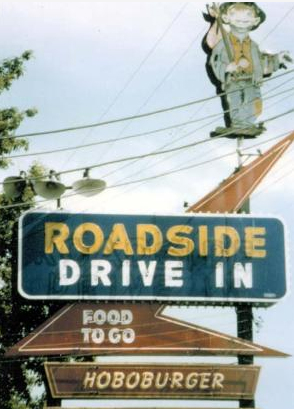
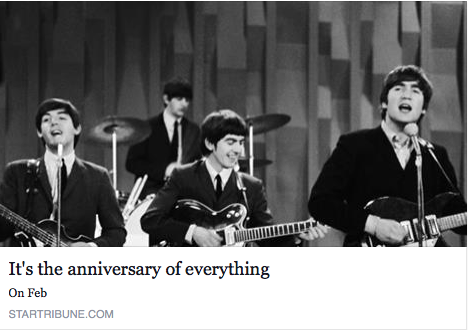
- Article by: BILL WARD , Star Tribune
- This article has been summarized.
A week doesn’t go by without marketers celebrating 50 years of something.... the Beatles’ first appearance on “The Ed Sullivan Show.”
In a year awash in 50th anniversaries, many salutes to the events, debuts and inventions of 1964 will not warrant all the hubbub. Arby’s, anyone? Acrylic paint? “The Addams Family”? (And those are just the A’s.)
Think about “Mad Men”: Cars, toys, fast food, all forms of consumption were being advertised to a postwar generation with money to spend.
Whether any of these anniversaries resonate today depends on the role their debuts played in the culture of the time, Meehan said. “It’s tapping into some meaningful values, whether it’s humorous or dramatic or indulgent or tragic. Just because it’s the 50th anniversary of something doesn’t mark it as an icon.”
Other factors that matter: timelessness, shared experiences and the nature of our passion. That holds true whether the item or event was hard news or pop culture, a surgeon general’s report on smoking or “Dr. Strangelove.”
“A while back we [marketed] the 75th anniversary of Scrabble,” said Jack Stanton, group director for brand sociology at Carmichael Lynch media agency. “I wouldn’t call that weighty. Some things are iconic to a niche of people. Barbie, to a certain niche of people, that’s powerful. Some things go deep, and some things go broad. The Beatles are both.”
Shared experience
Contemporary cultural relevance also is important, Stanton said.
That’s why we won’t see a salute to the VCR or the eight-track tape, both invented 50 years ago but now confined to the dust bins of history. But the popular movies and music we played on them have staying power.
“Some of these icons have a timeless quality to them. You see kids take to musicians we held up, like Bob Dylan,” Meehan said. Other icons might strike a similar nerve, but are only important to a certain generation. So one generation might retain a passion for the Easy Bake Oven, while another has the same emotional connection to Transformers or Hello Kitty, she said. “It’s that elusive element, and no marketer can produce it.”
Big doings back in the day
Today, the boomers — the last of whom were born in 1964 (another anniversary!) — are a nostalgic bunch. But it wasn’t always this way.
“It’s easy when you’re young to say, ‘New big things are happening all the time, and I won’t be nostalgic about them,’ ” Stanton said.
As it turns out, new big things were happening all the time five decades ago.
“Everything was in a massive state of flux,” Stanton said. “The earliest wave of boomers were coming of age, out of their parents’ shadows and able to make their own purchases and decide their own cultural boundaries.”
It was a fertile time not only for merchandise but for merchandising, Meehan said.
“The luxury of having cultural icons marketed to them had not happened before,” she said. “There was such prosperity and invention.”
The Addams Family and the Munsters turn 50 this year:
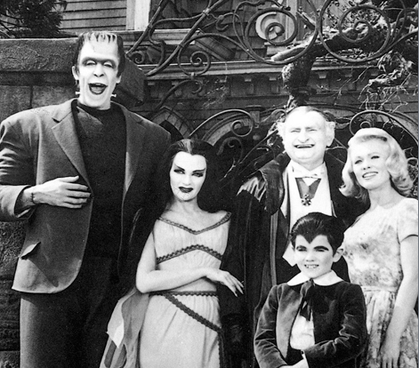
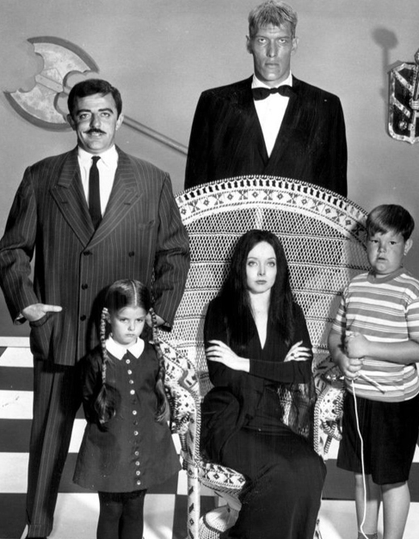
Remembering The Addams Family and The Munsters as they turn 50
By Greg Daugherty | September 18, 2014
Two anniversaries this year shouldn’t slip by unnoticed: Both The Addams Family and The Munsters are turning 50.
Introduced just six days apart in the fall of 1964, they represented something very different from the television we were accustomed to, as you may remember if you were around at the time. Unlike the picture-perfect families of most sitcoms, these were monsters — warts, fangs, neck bolts and all. The Addams Family, which aired first, was already familiar to our parents’ generation, at least to those who read The New Yorker, where its characters had been appearing in cartoons since 1938. The patriarch, Gomez, wasn’t exactly a monster but sort of a sinister version of Groucho Marx. His wife, Morticia, was said to be a witch, though she could easily have passed for a vampire. Their butler, Lurch, was a Frankenstein’s monster type, but more polite, better dressed and pretty good on the harpsichord.And there were others: goonish, lovable lightbulb-in-mouth Uncle Fester; Cousin Itt, a walking mop of hair; and a disembodied hand who went by the name of Thing. The Addamses were creepy, kooky, mysterious and spooky, as per their theme music — a song that, if you’re like me, still plays in your head five decades later.
The Munsters, meanwhile, worked from a more classic line-up, with a Frankenstein dad, vampire mom and grandpa, and werewolf son. The black sheep of the family was niece Marilyn, a pretty young college student.
The Monster Craze
The jokey monsters of the mid-'60s were part of a TV craze that began at least a decade earlier. In every city of any size, local stations seemed to have a Chiller Theater or Creature Feature, pairing a campy host with old black-and-white horror films. New York had Zacherley. Los Angeles had Vampira. Chicago had Mad Marvin, then Svengoolie, and still later Son of Svengoolie. Pittsburgh, where I lived for a time, had the great Chilly Billy Cardille, who also hosted wrestling.
Their movies gave us vampires, zombies, mummies, mad scientists and all the rest, plus the occasional giant spider, humongous ant or 50-foot woman. And sometimes they gave us nightmares.
It may have been a prepubescent guy thing, but many of us not only watched these dreadful movies but also spent our allowances on monster trading cards, Aurora monster models and monster magazines. The best of the latter was Famous Monsters of Filmland, edited by a horror and sci-fi buff named Forrest J Ackerman, a man often credited with coining the term “sci-fi.” Incidentally, if you find any old copies of FM in your attic, check their prices on eBay before you pitch them — and be grateful your mom didn’t.
Taming Fear
All in all, it was a second Golden Age of monsters, rivaling only the 1930s, which produced classic horror films like Dracula (1931), Frankenstein (1931), The Mummy (1932), The Invisible Man (1933) and countless others.
So why monsters, and why then? Maybe the easiest explanation is that we lived in a scary time and found escape in scary things we knew couldn't really harm us.
At school, our duck-and-cover drills reminded us that the capital-b Bomb could fall from the sky at any moment. We lived through the Cuban Missile Crisis, when atomic war with the Soviet Union seemed imminent. We saw President Kennedy and his accused assassin shot to death, Oswald on live television.
Perhaps not coincidentally, it was just 10 months later that The Addams Family and The Munsters came into our lives — for many of us on the same TV sets where we’d watched the very-real horrors of November 1963.
Monsters kept us amused until we were old enough for more grown-up escapes like sex, drugs, rock 'n' roll and careerism. As to the Addamses and Munsters, both of their shows were history by 1967, canceled after two seasons.
None of this is meant to exaggerate their cultural significance. Their goal, after all, was to give us a few laughs every week and sell as much cereal and toothpaste as possible. How well the old episodes have stood the test of time is a probably matter of taste. You can sample some of them online if you dare (and have a lot of time on your hands).
But the fact that they are half a century old? Now that’s scary.
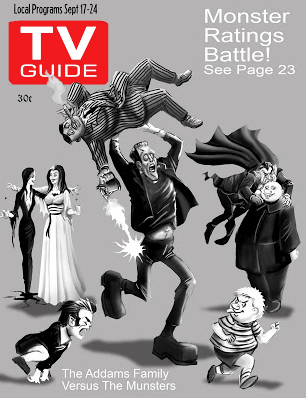
Wilderness Act of 1964
50 years ago the Wilderness Act of 1964 was signed into law. This law protected the 1 million acres of federal BWCA land along with another 8 million acres of land around the country with additional protections from human impact. It added the "Wilderness" to what was just previously known as the Boundary Waters Canoe Area. Within the last 50 years, another 100 million acres of land has been added by Congress to be protected under the act. I encourage folks to read more about the Wilderness Act and its history. 50 years is a short period of time, but I certainly look forward to the future when my children, children's children, and beyond can experience the uniqueness of protected wilderness areas.
“A wilderness, in contrast with those areas where man and his own works dominate the landscape, is hereby recognized as an area where the earth and its community of life are untrammeled by man, where man himself is a visitor who does not remain.” - Quote from Wilderness Act
____________________________________
Experience the moment that changed music forever!
Here's Met Stadium when the Beatle's played. (Our own Claudia Carley Droel was there!)
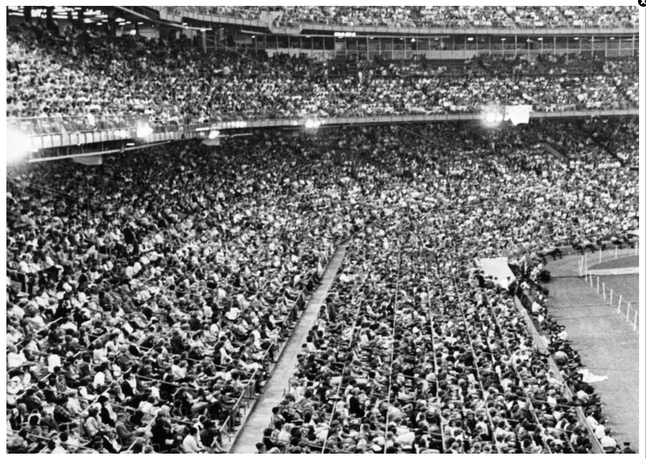
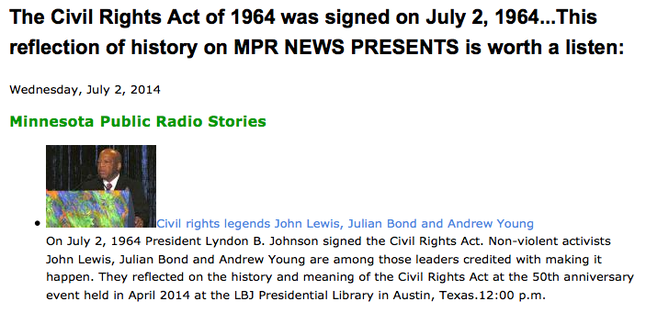
CNN's "THE SIXTIES"
CNN's documentary series "The Sixties," aired last summer, and focused on various events during the tumultuous decade, including the civil rights movement, the Vietnam War, the Kennedy assassination, the British invasion of pop music, etc.. The series is often repeated and can be viewed on line.
They're a collaboration with Tom Hanks, Gary Goetzman and Mark Herzog.
Episode 1: Television Comes of Age
Episode 2: The World on the Brink
Episode 3: The Assassination of Kennedy
Episode 4: The War in Vietnam
Episode 5: A Long March to Freedom
Episode 6: The British Invasion
Episode 7: The Space Race
Episode 8: 1968
Episode 9: The Times They are A-Changin'
Episode 10: Sex, Drugs, and Rock N' Roll
.png)
LOST IN THW FIFTIES
Here's a short video Lost In the Fifties-Another Time, Another Place.....Take a trip back in time and relive the culture and our childhood. Such fun!! (submitted by Jim Stork) https://www.youtube.com/watch?v=jjj9VKKSV2g&feature=player_embedded
.png)
